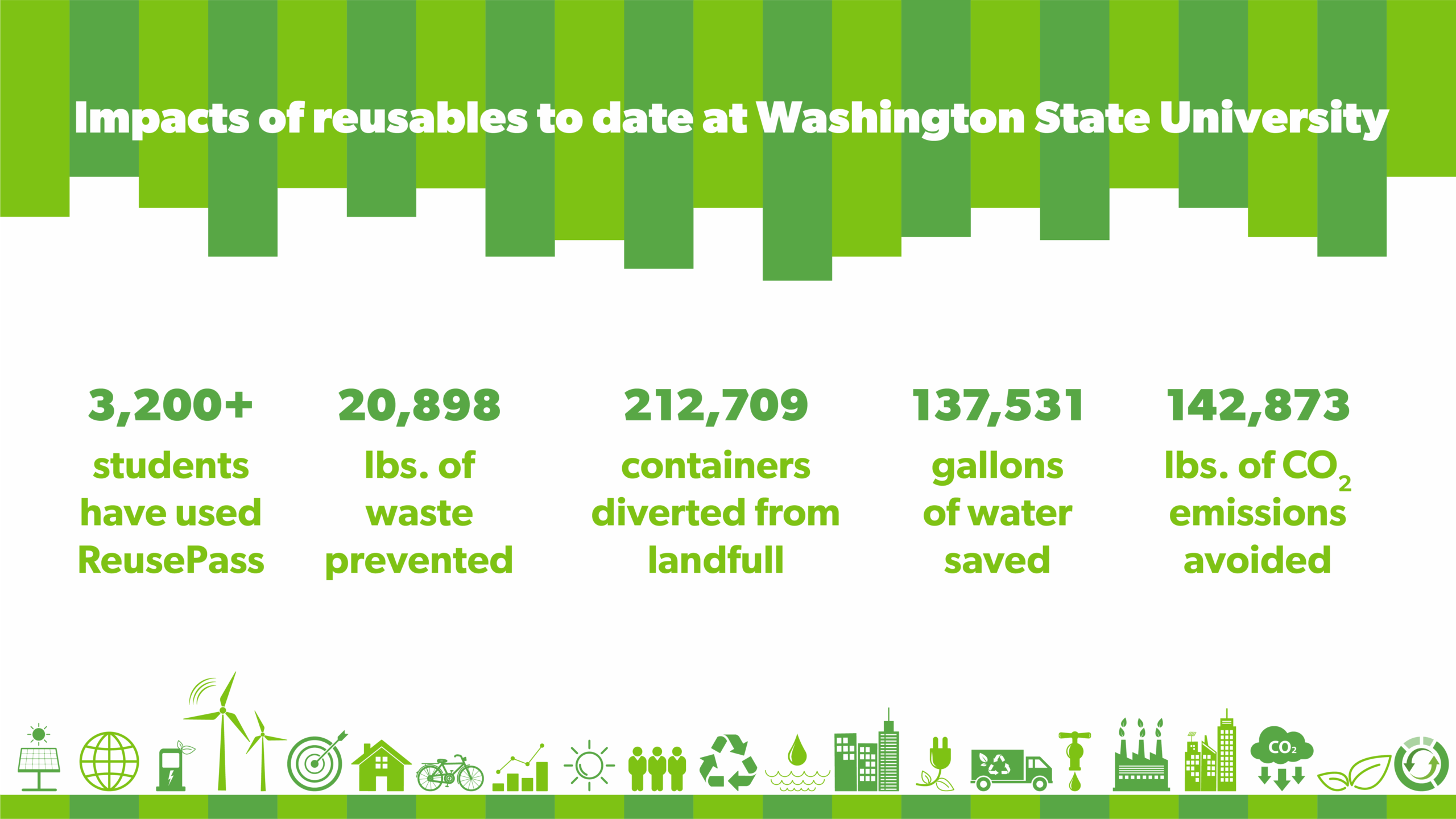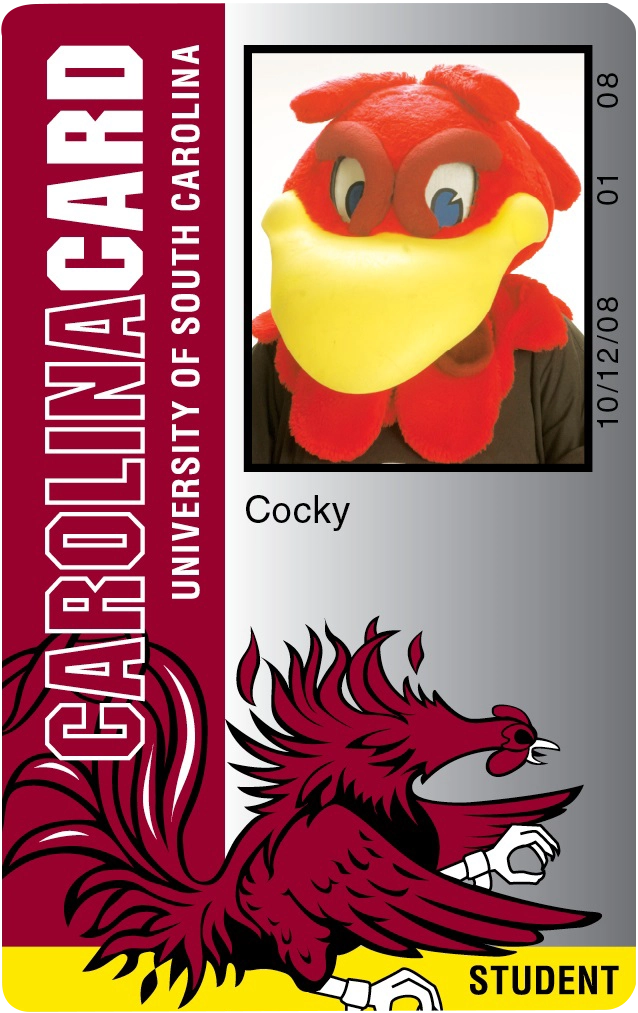Reusable container tracking software is elevating sustainability efforts in residential dining at Washington State University (WSU). Topanga’s reusable container solution, ReusePass, is simple and effective: check out, enjoy, and return.
In August of 2023, WSU introduced ReusePass at their mid-sized dining center, Northside Café. The goal was to enable students and dining staff to test the reusable containers and management software prior to a full rollout. The test was successful, and in the spring of 2024 ReusePass launched at all three residential dining locations.
To participate in Topanga’s ReusePass, students setup an account using their WSU credentials. Then they have the option to add their unique QR checkout code to their mobile wallet for easy access.
When a student enters one of WSU’s three participating ReusePass locations, a dining services employee scans the student’s QR code and a reusable container’s unique QR checkout code, labeled on the container. The student pays using their declining balance account and enjoys the meal wherever and whenever they please.
We scan your unique QR code and the QR code on your container, and now we have made that one-to-one connection between person and container.
The container is now marked as “in use” by the system, and its status is tracked until it is returned, sanitized, and prepared for reuse.
“If we see that you are checking out a container, we scan your unique QR code and we scan the QR code on your container, and now, we have made that one-to-one connection between person and container,” said Jason Butcherite, the director of dining services at Washington State University.
To return the container, the student simply drops it off at a return receptacle located in one of the participating dining locations.
At Topanga’s 70-plus dining partnerships, the return rate averages 98%. Butcherite reports the same impressive return rate at WSU.
Topanga created the ReusePass software that powers WSU’s reusables program, but they do not make the containers or endorse a particular manufacturer. Butcherite explains that Topanga is container agnostic, and his team was empowered to choose the containers that best met their environment.
For WSU, selecting the right shape and size for the containers was important. They opted for two reusable containers, different in both shape and color.
The general-use container is an 8x3x3-inch clear clamshell manufactured by Whirley Drink Works. It is broadly available across all three residential dining locations, and it is used when students opt to carry out a meal from a dining facility.
Our grill station operates exclusively off mobile ordering. By default it comes in a green container, so when they come into our check out space we aren’t trying to ring them up for the order.
For to-go orders made online or via the mobile ordering app, they use a 6x9x3-inch green container manufactured by GET Enterprises. This was chosen with intent as the green color signals to staff that the student placed a to-go order online, and they have already paid for it.
“When students place an order for our grill station, for example, it operates exclusively off our mobile ordering and payment solution, and so by default, it comes in a green container,” explains Butcherite. “That way, when they come into our check out space, we aren’t trying to ring them up for the order.”
Staff simply scans the student’s unique QR code from their phone and the QR code from the container holding their order. The container itself serves as the visual indicator to let the cashier know that the person has already paid.
“Green means go,” he jokes.

Assuming the container is returned in WSU’s allotted three-day window, there is no charge to utilize ReusePass. For the 2% of containers that are not returned, the person incurs an $8 fee that is applied to their WSU student account.
Butcherite notes that some of the fee money is used to recoup the cost of the lost container, but a portion of it sponsors future sustainability initiatives.
Many of WSU’s containers have been in use for two years, and 99% of Topanga’s RFID labels have remained intact wash cycle after wash cycle. Butcherite says the Topanga operator dashboard shows the number of uses for each container, and some containers have topped 70 uses.
We added RFID readers into our dish rooms to negate the need for a dining services employee to manually scan the containers back in.
The efficiency of the return process keeps the return rate high.
Receptacles, like those used to collect trash, are stationed at the dining centers to make it easy on users. The receptacles – also from container-provider GET Enterprises – streamline collection processes for dining service employees as well.
When the used container makes it to the washing facility, WSU further automates the check-in process.
“We added RFID readers into our dish rooms to negate the need for a dining services employee to manually scan the containers back in,” says Butcherite. “As they enter the dish washing system, the reader scans and registers them as the cleaning process begins.”
For now, WSU utilizes ReusePass solely in residential dining, but there are bigger plans.
“Right now, it is purely residential, but we have a roadmap of future plans for how it can enhance our retail dining as well,” Butcherite notes.
Aside from the advantages it offered in support of WSU’s sustainability initiatives, Topanga’s technology made financial sense for the institution.
We had good pricing on our single-use containers, but when you do the financial pro forma and look at the environmental impact of reusables, it is a win-win.
“When you do a financial analysis and run the numbers, ReusePass made a lot of sense for us,” Butcherite says. “We had pretty good pricing on our single-use containers, but when you do the financial pro forma and look at the environmental impact of reusables, it is a win-win.”
Sustainability is valued across the intuition, and it has become an increasingly important pillar of the dining services’ program.
In addition to the ReusePass program, Butcherite cites other initiatives. These include a Marine Stewardship Council certification for sustainably-sourced seafood; a partnership with the Humane Society to increase plant-based options; and a food waste control mechanism called Streamline – also from Topanga – that will launch this fall at WSU’s largest residential dining center.
As his team continues to pioneer initiatives to meet the institution’s environmental goals, he says he’ll always consider ReusePass a key to leading the way. “It accelerated our sustainability efforts, and it showed that environmental stewardship can also make financial sense.”
HID’s 2024 State of Physical Access Control Report showcases significant market changes since the last report was issued two years ago. In partnership with IFSEC Insider, HID conducted their study from November 2023 until January 2024, distributing the survey to users through email, media outlets, social media, and internal teams. In all, more than 1,200 respondents from a wide geographical range and an array of job roles participated.
The report found that 63% of companies actively use physical ID badges, but mobile credentials are gaining traction. Nearly 40% of respondents are using mobile credentials, up 7% from 2022.
Despite the migration to advanced technologies, one in three companies still support prox and nearly 30% still have systems that utilize mag stripe cards.
Still physical ID badges remain the prevailing tool for access. The survey found:
Similar to the rise seen in mobile access, the use of biometrics for access control also reached 40%, an increase of 9% since the last survey.
An slightly greater increase (11%) occurred in the use of logical access, spurred by the shift in workplace environments following the pandemic. Today, more than two-thirds of organizations use it.
Nearly half of all respondents cited ‘improving user convenience’ as the biggest challenge faced on a day-to-day basis. Other concerns included the ease of physical access administration, protection against the threat of security vulnerabilities, issuance and revocation of ID credentials, and integration with other enterprise systems.
This year’s study identified five overarching physical access trends.
The report showed that nearly 2 in 5 organizations are using mobile credentials. Security professionals project 80% of organizations to deploy mobile IDs within the next five years. Mobile IDs allow users to access their workplace, log billable hours and even print documents through the convenience of their ID being stored in their phone or smart watch mobile wallet.
Trends show that the global smart building market size is predicted to increase by 4 times, and standardization allows for development of this overall market. Nearly half of survey respondents noted smart buildings and flexible workplaces as one of the top three trends shaping the access control industry. Oftentimes, building usage for utilities such as heating, lighting and power are tracked through mobile credentials throughout the day to monitor usage. Implementing access control with the feature to track these utilities allows for sustainable and cost-effective building usage.
Nearly two-thirds of respondents cited that sustainability is important, and employees have an influence or are fully consulted when a physical access control system is updated or installed. The move towards mobile credentials rather than physical cards allows for sustainability and convenience to work together to benefit the organization and the environment.
About 40% of respondents have plans to incorporate AI learning into their access control environments, but the same percentage remains unsure of its benefits. Advances in AI are making it a more popular choice to assist with areas like video surveillance and feedback.
Biometrics' role in access control is growing rapidly. 26% stated they currently use biometrics and another 33% stated they plan to test or implement biometrics in the next five years. Fingerprint readers are used more widely in North American and European markets, but in Africa, Asia, and Latin America, there is a shift from fingerprint to facial recognition. Contactless biometrics like facial recognition, iris recognition, and touchless fingerprint options are becoming more common.
The 2024 report can be read here.
For students at the University of South Carolina, finding the right dining options on and off campus has never been easier. With the implementation of Grubhub’s technology for mobile food ordering and delivery, students now have the option to order items ahead for pick-up or directly to their location via robot delivery.
Aramark Collegiate Hospitality is the food service contractor for the university’s dining services. Together, they are constantly evolving, adjusting their style and systems to optimize the user experience.
South Carolina began their partnership with Grubhub in 2018 offering diners the opportunity to mobile order. Since then, they have expanded to add Grubhub Ultimate for kiosk ordering, APEX Food Lockers, and Starship Robots.
This fall, students will be able use a meal plan swipe to enter dining facilities with all-you-can-eat options, with access validated by the Grubhub app. They can eat from the buffet or use a kiosk to place a specialized made-to-order option.
“We have a large campus and a large student population, so dining is always looking for ways to enhance the student experience,” says Danielle Hewitt, Unit Controller for Aramark Collegiate Hospitality at the University of South Carolina. “Accessibility, speed of service and convenience are important to our students, so this partnership helps us deliver on that.”
The CarolinaCard acts as a campus identification card and allows users to ‘pay’ for food with meal swipes, dining dollars, or CarolinaCash at both on and off campus dining locations.
 Grubhub Ultimate is a suite of hardware and software that includes point of sale devices integrated with the Grubhub app and other systems; in-store and in-app customer displays that show real-time order status; in-store self-ordering kiosks; and back-of-house kitchen display systems. Integrating this technology and the CarolinaCard allows users to order a meal and pay for it within one app.
Grubhub Ultimate is a suite of hardware and software that includes point of sale devices integrated with the Grubhub app and other systems; in-store and in-app customer displays that show real-time order status; in-store self-ordering kiosks; and back-of-house kitchen display systems. Integrating this technology and the CarolinaCard allows users to order a meal and pay for it within one app.
In January of 2024, Grubhub launched the off-campus program for South Carolina students enabling them to use their flex funds at 375,000 Grubhub merchants around the country. Since then, more than 9,000 orders have been made through this system.
Steve Iarocci, senior director for client success and operations at Grubhub, credits the university’s proactive and innovative dining team for the successful implementation.
“The South Carolina campus has a knack for thinking outside the box and consistently using technology in new ways, such as operating ghost kitchens or leveraging Grubhub’s easy-to-use platform for a student-run grill,” says Iarocci. “By evolving alongside Grubhub and keeping on the cutting edge of the modern dining experience, the university ensures students and faculty continue to engage year in and year out.”
Let’s take the school mascot Cocky, for example. Cocky could order his morning coffee on his phone to the food locker closest to his 9 a.m. class and pick it up on the way. At lunch, he could use a kiosk in the dining hall to customize his sandwich and grab it at the pick-up counter a few minutes later. Later that evening at the library, Cocky could place an order for an acai bowl to be delivered to him via a robot.
Since signing on with Grubhub, South Carolina dining has grown its operational footprint significantly.
“Even with our growing campus population, we have to be able to effectively service our students within our existing dining footprint,” explains Hewitt. “With Grubhub, we have been able to increase orders by 44%, sales by 54%, and Grubhub users by 24%.”
This fall, the University of South Carolina is piloting a technology where students can use a meal plan swipe to enter dining facilities with all-you-can-eat options, with access validated by the Grubhub app. They can eat from the buffet or use a kiosk to place a specialized made-to-order option. Additionally, students can request a reusable container or a to-go cup from within the app.
Even with our growing campus population, we have to be able to effectively service our students within our existing dining footprint, and we have increased orders by 44% and sales by 54%.
“The use of the all-you-care-to-eat platform will aid in speed of service, decrease system errors, and provide easier access to reports,” Hewitt says. “Our goal is to enhance the experience that our students have on campus, so ensuring that the ability to access food is easy and accessible is vital to their experience on campus.”
With options this expansive, the user experience is still confined singularly to the Grubhub app, allowing for convenience and efficiency. As the university adapts new features, Grubhub is able to reflect those changes within the app.
The app provides a one stop shop for all dining needs for students,” says Hewitt. “Being able to access all these functions via their phone makes ordering food on campus seamless and easy, and Grubhub has been so great to work with. They are a leader in the industry and their brand resonates with our students.”

